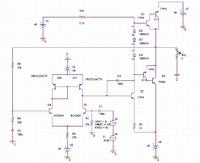Audioguru
Advanced Member level 7

- Joined
- Jan 19, 2008
- Messages
- 9,461
- Helped
- 2,152
- Reputation
- 4,304
- Reaction score
- 2,011
- Trophy points
- 1,393
- Location
- Toronto area of Canada
- Activity points
- 59,764
The differential pair has a high emitter resistance and drives the low input resistance of the TIP41 so its gain is low or it has loss.
The TIP41 has the most gain of maybe 120.
The darlingtons are emitter-followers with no gain.
Therefore the total open-loop gain is low.
The TIP41 has the most gain of maybe 120.
The darlingtons are emitter-followers with no gain.
Therefore the total open-loop gain is low.

